Today, the Center for Law, Energy and the Environment (CLEE) at Berkeley Law and the Emmett Institute on Climate Change and the Environment at UCLA Law are releasing a new report, Data Access for a Decarbonized Grid, which highlights key policy solutions to expand access to the energy data needed to operate a fully decarbonized grid.
Join our webinar on Wednesday, April 7 at 10am PT to learn more.
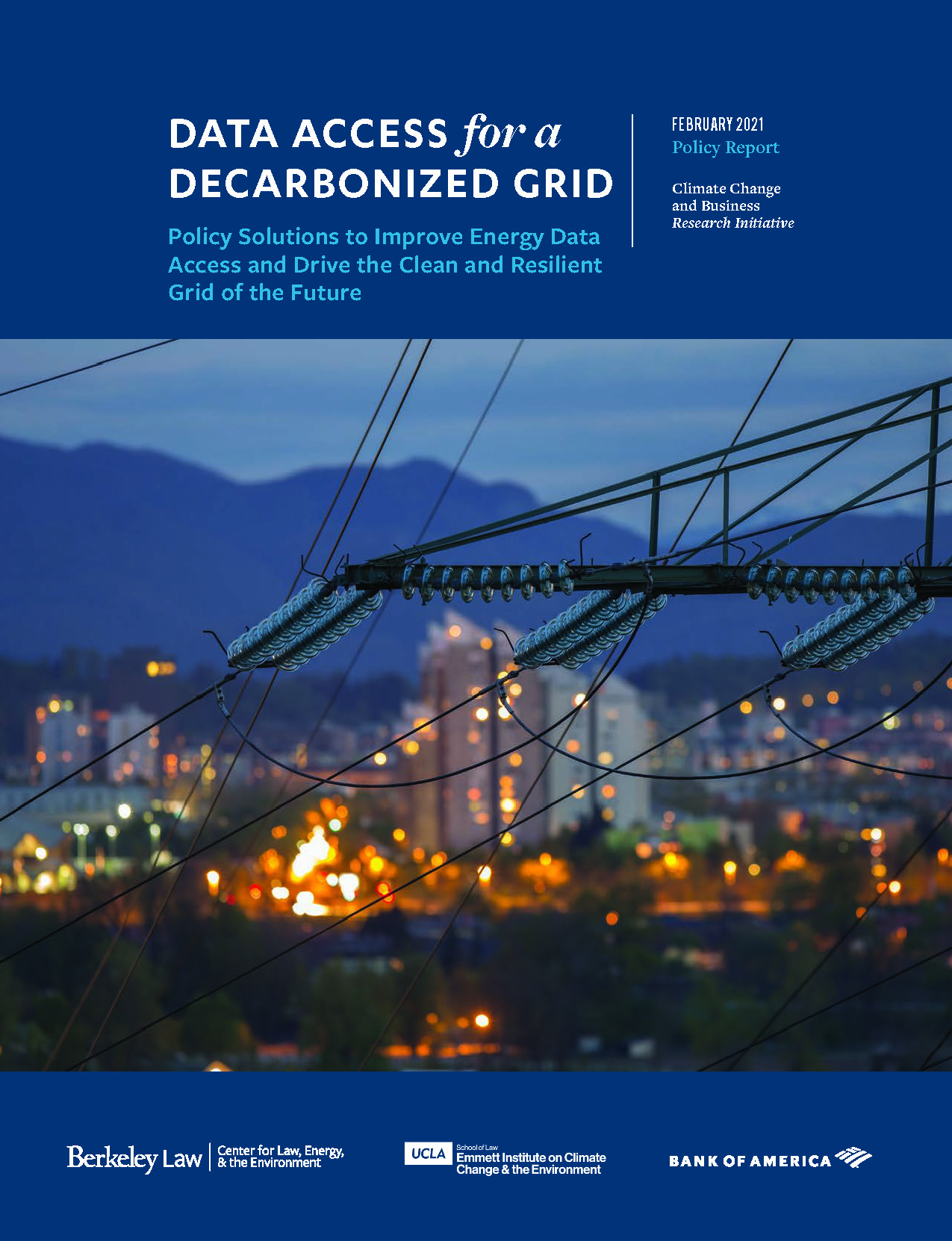
As California approaches the state target of delivering 100 percent zero-carbon power by 2045, state leaders face the challenge of decarbonizing electricity by rapidly expanding the use of renewable energy sources. At the same time, they face increasingly severe heat waves and wildfires that threaten the reliability and resilience of the grid.
Individuals, businesses, and utilities are turning to a growing group of flexible grid technologies to meet this challenge—such as distributed renewables, small-scale battery storage, and smart appliances and building energy management. They are becoming increasingly mainstream and affordable. But these technologies, which facilitate the flexibility needed to deliver reliable power on a fully renewable grid, also rely on constant flows of energy data in order to operate effectively and efficiently.
The data include grid structure and operations data that depict system assets and capacity; customer-level data on consumption and rates; and real-time performance data for distributed generation and storage assets. Utilities, technology providers, and residents already exchange these data in abundant quantities. However, a set of regulatory, privacy, and incentive-based challenges limit the ability of regulators, utilities, and developers to generate and manage the data optimally.
These barriers include utility business and regulatory incentives that reward major physical capital investments over data management initiatives; potentially outdated rules restricting customer data-sharing; and concerns around cybersecurity and physical grid asset security.
To identify solutions to these challenges, CLEE and UCLA Law’s Emmett Institute convened a group of energy data experts in August 2020, and our new report details the solutions including:
- Adopting performance-based regulation of electric utilities to provide financial incentives for high-quality, efficient data generation and management.
- Re-examining the California Public Utilities Commission’s 15/15 rule for customer data aggregation (which sets numerical limits on customer cohorts) and considering use of differential privacy methods instead.
- Modernizing utility IT systems to adapt to rapidly evolving technological and customer needs.
Ultimately, a fully decarbonized electrical supply will require a large-scale restructuring of the grid across generation, distribution, and consumption activities. In the face of growing threats to grid resilience and reliability, California energy leaders will have to help energy producers and consumers throughout the state gain access to the flexible grid technologies needed to maximize efficiency and minimize service disruption. Ensuring the optimal flow of energy data is vital to that effort.
You can access the report and its full set of recommendations here.
You can also learn more about state priorities for increasing access to energy data by joining CLEE and the Emmett Institute for a free webinar on Wednesday, April 7 at 10am PT. Speakers include:
- California Energy Commissioner Andrew McAllister
- Clean energy expert Audrey Lee
- Sky Stanfield of Shute, Mihaly & Weinberger
We will discuss policy opportunities and technology needs to accelerate the transformation of the grid. RSVP here. Hope you can join!
This post was co-authored with Ted Lamm and cross-posted on Legal Planet.
With the presidential election over, Joe Biden faces a U.S. Senate that still hangs in the balance. But even with a Democratic runoff sweep in Georgia next month, it will be very divided. So what will be possible for a President Biden and his administration to achieve on climate change?
Agency action, foreign policy changes, and spending can all make a difference on emissions, with any COVID stimulus and budget deals with Congress, if feasible, providing potential avenues for further climate action. Here are some ideas along those lines, broken out by key sectors of the economy.
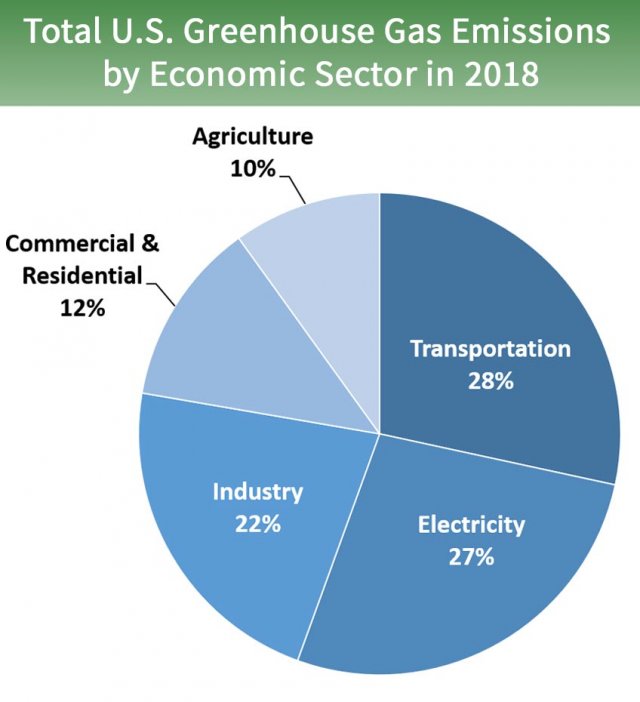
Action on Transportation
As the EPA chart above of 2018 emissions shows, transportation contributes the largest share of nationwide greenhouse gas emissions at 28%. The best way to reduce those emissions is to decrease per capita driving miles through boosting transit and the construction of housing near it, as well as switch to zero-emission vehicles, primarily battery electrics.
Transit-oriented housing is largely governed by local governments, who generally resist construction. Absent state intervention or federal legislation from a divided Congress, the Biden administration will have to make surgical regulatory changes directing more grant funds to infill housing and potentially use litigation and other enforcement tools to prevent and compensate for racially discriminatory home lending and racially exclusive local zoning and permitting practices.
On transit, a Biden administration would be very pro-rail, especially given the President-elect’s daily commuting on Amtrak in his Senate days. If the Senate flips to the Democrats, high speed rail could be a big part of any bipartisan COVID stimulus package, if it happens, which would be a lifeline to the California project that is otherwise running out of money. Other urban rail transit systems could benefit as well, and the U.S. Department of Transportation could favor and streamline grants for transit over automobile infrastructure. Notably, LA Metro CEO Phil Washington, responsible for implementing the nation’s most ambitious rail transit investment program in Los Angeles County, is chairing Biden’s transition team on transportation.
On zero-emission vehicles, Biden may have relatively strong tools to improve deployment of this critical clean technology. First, perhaps through a budget agreement with Congress, he could reinstate and extend tax credits for zero-emission vehicle purchases, which have expired for major American automakers like General Motors and Tesla. Second, he could use the enormous purchasing power of the federal government to buy zero-emission vehicle fleets. And perhaps most importantly to California, his EPA can rescind its ill-conceived attempt at a fuel economy rollback for passenger vehicles and then grant the state a waiver under the Clean Air Act to institute even more stringent state-based standards, toward Governor Newsom’s new goal of phasing out sales of new internal combustion engines by 2035.
Reducing Electricity Emissions
The electricity sectors comes in a close second place, with 27% of the nation’s greenhouse gas emissions. The move toward renewable energy, particularly solar PV and wind turbines, is so strong that even Trump had difficulty slowing it down during his single term in office, in order to favor his fossil fuel supporters. But nonetheless, the Trump administration created some strong headwinds which can now be reversed.
First and foremost, President-elect Biden can drop the tariffs on foreign solar manufacturers, which drove up prices for installation here in the United States. Second, as with the zero-emission vehicle tax credits, a budget deal with Congress could bolster the federal investment tax credit for solar, which steps down from the initial 30% toward an eventual phaseout for residential properties and 10% for commercial properties. The credit could also be extended to standalone energy storage technologies, like batteries and flywheels, if Biden budget negotiators play their hands well (easy for me to say). A Biden administration could also improve energy efficiency by dropping weak regulations on light bulbs and appliances like dishwashers at the U.S. Department of Energy and introducing more stringent ones instead.
Legislatively, any COVID stimulus deal (again, if it happens) could potentially contain money for a big renewable energy buildout, including for new transmission lines, grid upgrades, and technology deployment. In terms of regulations, if Biden is able to get any appointments through the Senate to agencies like the Federal Regulatory Energy Commission (FERC), that agency could make climate progress by simply letting states deploy more renewables and clean tech, including demand response, as well as potentially supporting state-based carbon prices (a move supported by Trump’s FERC appointee Neil Chatterjee, which promptly resulted in his demotion last week).
Slowing Fossil Fuel Production
The two big moves for the Biden administration will be to stop new leases for oil and gas production on public lands (including immediately restoring the Bear’s Ears and Grand Staircase-Escalante national monuments) and bringing back the methane regulations on oil and gas producers that the Trump administration rolled back. As a bonus, his Interior Department could engage in smart planning to deploy more renewable energy on public lands, where appropriate, including offshore wind.
Other Climate Action
The list goes on for how the Biden administration can embed smart climate policy into all agencies and facets of government, with or without Congress. Of particular note, his appointees at financial agencies like the Federal Reserve and U.S. Securities and Exchange Commission could bolster and require climate risk disclosures for institutional and private investors. The U.S. Office of Management and Budget could ramp back up, based on the best science and economics, the social cost of carbon, which represents the cost in today’s dollars of the harm of emitting a ton of carbon dioxide equivalent gas into the atmosphere. This measure provides much of the economic justification for the federal government’s climate regulations. And of course, President-elect Biden can have the U.S. rejoin the 2015 Paris climate agreement immediately upon being sworn in (though the country will need to set a new national target).
Overall, Biden’s win means the U.S. will regain some climate leadership at the highest levels, with much that can be done through congressional negotiations, agency action, and spending. However, the stalemate in the US Senate likely means that any hopes for big new climate legislation will be dashed. As a result, continued aggressive action at the state and local level, as well as among the business community, will be critical to continue to help push the technologies and practices needed into widespread, cost-effective deployment to bring down the country’s greenhouse gas footprint.
One election certainly won’t solve climate change, and the costs continue to rise to address the impacts we’re already seeing from extreme weather. But given the current political climate, the actions described above could allow the U.S. to still make meaningful progress to reduce emissions over the next four years and beyond, even in an era of divided government.
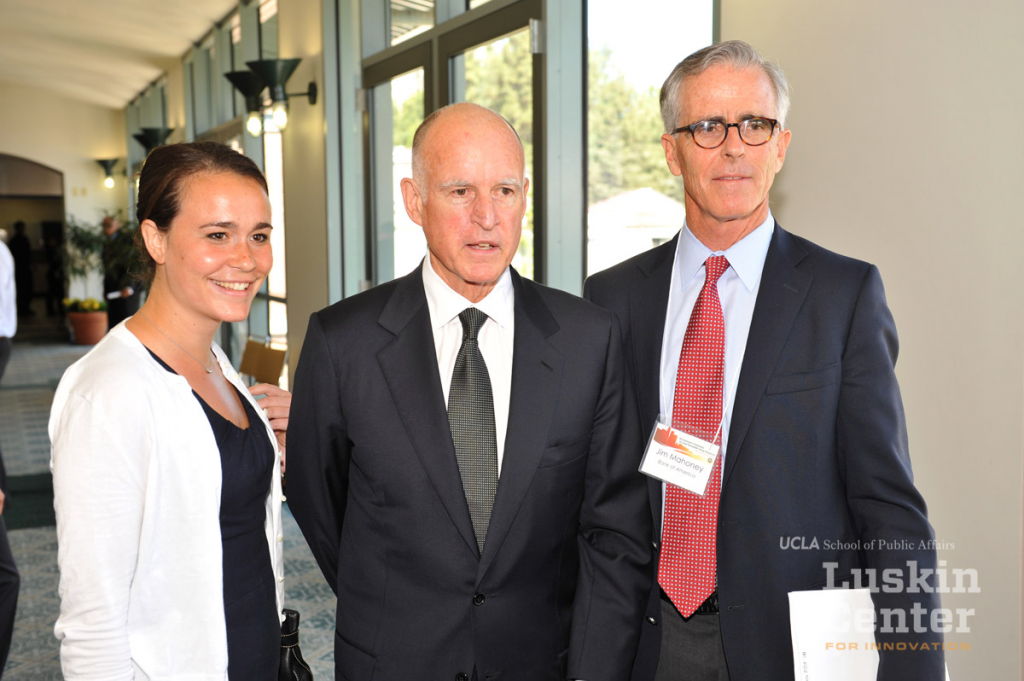
Jim Mahoney was perhaps an unlikely climate hero. A senior Bank of America and FleetBoston Financial executive for 25 years who tragically passed away this past weekend at the age of 67 (the result of complications from injuries he sustained in a bicycle accident last year), Jim’s work focused on global corporate strategy and public policy for a major financial institution. Climate change would have been just one component of his portfolio of issues affecting banking.
But back in 2008, Jim teamed up with his former boss, then-California Attorney General Jerry Brown, to make a difference on climate policy. Brown and Mahoney, through Brown’s then-climate advisors Ken Alex (now with Berkeley Law) and Cliff Rechtschaffen (now a California public utilities commissioner), approached Rick Frank (now with UC Davis Law) and Steve Weissman (now with the Goldman School) at UC Berkeley Law and Sean Hecht and Cara Horowitz at UCLA Law to launch a Climate Change and Business Initiative at the law schools.
The initiative was only planned for one year, to focus on then-emerging topics in climate policy like infill housing, small-scale renewable energy, low-carbon agricultural practices, and residential energy efficiency financing. The idea was to convene small groups of experts for roundtable discussions that would inform policy reports on business solutions to reduce greenhouse gas emissions. These reports in turn would ideally educate California legislators and regulators on cutting-edge, consensus climate solutions.
But with Jim’s quiet but committed leadership at Bank of America, that one-year initiative soon grew to a multi-year program that has to this day covered multiple climate and clean energy issues and influenced legislation and regulation in California and throughout the country. Here are just a few highlights:
- Pioneering climate and clean energy legislation: The initiative helped inform the California’s first-in-the-nation energy storage mandate, which proved so successful that the initial targets have been increased and expanded. It also inspired legislation to streamline permitting for utility-scale solar PV on degraded agricultural land, as well as to increase California’s renewable energy requirements.
- Regulation and funding: Recent work on boosting energy retrofits for low-income multifamily buildings was incorporated into state energy planning, while a biofuels convening helped steer millions of dollars of state energy funding for this low-carbon industry.
- Inspiring out-of-state action: A number of the in-state policy recommendations have informed similar work elsewhere, such as our stakeholder process to identify prime areas for renewable energy development. And in general, California legislation on climate and energy has inspired similar action across the United States, particularly on renewable energy and zero-emission vehicles.
- Cataloguing climate solutions: All of the initiative’s recommendations over the years are compiled in the easy-to-use website climatepolicysolutions.org.
- Influencing public debate: In addition to convenings and reports, the initiative has led to publication of numerous op-eds (most recently on ways to make the electricity grid more resilient and low-carbon), webinars (such as on priority climate solutions with California’s top climate leaders), and conferences (including recently on expanding zero-emission freight technologies at Southern California’s ports).
- Training future climate leaders: Throughout the research involved with this initiative, the law schools have included numerous law students and recent graduates to help conduct that work. Many of them have gone on to further this work through their professional employment at law firms, clean technology companies and government agencies, among others, with one recent fellow now advising the Biden campaign on climate policies.
And on a personal note, Jim’s initiative provided me with an opportunity to dedicate my career to working on all of these important issues, as I was first hired at Berkeley Law for that one-year initiative before eventually directing the climate program at the law school’s Center for Law, Energy and the Environment (CLEE).
While many individuals have been involved in the Climate Change and Business Initiative over the years, none of this work would have been possible without Jim’s leadership at Bank of America. Along with his colleagues, including Rich Brown, Brian Putler, Kaj Jensen, Alexandra Liftman, and others, Jim ensured that the initiative had strong institutional support and funding to carry out this work, without ever interfering or trying to influence the content of what the initiative covered or recommended. Quite the opposite, he helped the law schools’ harness the Bank’s expertise and contacts to further the dialogues and reach of the findings.
Jim’s death is a blow to his family, friends, colleagues, and those of us who care about the issues he helped advance. The Boston Globe published a worthy tribute to his career and extensive family, including his volunteer stint driving then-presidential candidate Jerry Brown around New Hampshire and Wisconsin.
Jim will be missed, but his legacy of climate leadership will live on in the work and policies he helped advance, and in the lives he touched. May he rest in peace.
On January 27, 2017, just one week after Trump’s inauguration, UC Berkeley Law’s Henderson Center for Social Justice held a daylong “Counter Inauguration,” featuring various panels in reaction to Trump’s victory. I spoke on an afternoon panel that day entitled “Monitoring the Environmental, Social and Governance Impacts of Business in the Trump Era” and offered my predictions on what the Trump years would bring for environmental law and policy.
I recently reviewed these predictions, three months out from the upcoming November election, to see how they measured up against the reality of Trump’s near-complete term in office. Bottom line: these predictions mostly tracked with what happened with Trump and his administration’s leaders, albeit with some steps I missed, some that never came to pass, and some positive outcomes for environmental protection.
First, I predicted the Trump Administration would follow through on the campaign pledges to boost fossil fuels in the following ways:
- Opening up public lands for more oil and gas extraction
- Slashing regulations that limit extraction and related pollution, such as the Clean Power Plan and methane rules
- Weakening fuel economy rules for passenger vehicles
- Financing more infrastructure that could boost automobile reliance (i.e. more highways and less transit)
These were all relatively predictable actions, and they all pretty much happened as predicted. On public lands and fossil fuels, Trump rolled back National Monument protection at Utah’s Bears Ears and Grand Staircase-Escalante, as well as streamlined permitting for oil and gas projects on public lands. On environmental rules in general, here is a list of 100 environmental regulations that the administration has tried to reverse. On vehicle fuel economy standards, here’s my article on EPA’s proposed rollback. And transit funding went from 70 percent of transportation grants under Obama to 30 percent under Trump, with the rest funding highways.
Second, I predicted that his administration would try to undermine clean technologies by:
- Weakening tax credits for renewables and electric vehicles
- Undoing federal renewable fuels program
- Revoking California’s ability to regulate tailpipe emissions
- Attempting to undermine California’s sovereignty to regulate greenhouse gases through legislation
- Cutting funding for high speed rail and urban transit
- Withdrawing from Paris agreement
On these predictions, I was correct on most accounts. The administration did weaken tax credits for renewables (both by not extending them or preventing them from decreasing over time, save for a recent one-year extension on wind energy as a budget compromise) and electric vehicles (by letting them expire and threatening to veto Democratic legislation that would have extended them in a recent budget bill). His EPA did revoke California’s waiver to issue tailpipe emission standards. And he famously withdrew from the Paris agreement (to take actual effect later this year) and has tried to cancel almost $1 billion in high speed rail funding in California.
But I was incorrect that the administration would pursue legislation to preempt California’s (and other states’) sovereignty to set their own climate change targets. There was little appetite in Congress to do so, though Trump’s Justice Department did seek unsuccessfully to declare California’s cap-and-trade deal with Quebec to be unconstitutional. And his record on renewable fuels is more mixed but did deliver some gains to corn-based ethanol producers, though the environmental benefits are suspect with this type of biofuel. I also failed to predict the administration’s efforts to impose tariffs on foreign solar PV panels and wind turbines, which slowed those industries somewhat.
Finally, I predicted some possible bright spots for the environment in the Trump years, much of which did occur:
- Clean tech generally has bipartisan support in congress
- Infrastructure spending in general could be negotiated to benefit non-automobile investments
- Lawyers can stop or delay a lot of administrative action on regulations
- A shift will happen now to state and subnational action on climate, which probably needed to happen anyway
Sure enough, clean technology, particularly solar PV, wind and batteries, has continued to increase in the Trump years, though not at the same pace as under Obama due to the policy headwinds. But infrastructure spending has definitely favored automobile interests, as noted above.
But more importantly, two critical predictions did come to pass. First, attorneys have successfully stopped most administrative rollbacks. In fact, the administration has an abysmal record defending its regulatory actions in court. As NYU Law’s Institute of Policy Integrity has documented, the administration has lost 94 cases in court and won only 12 to date, as tracked in this chart:
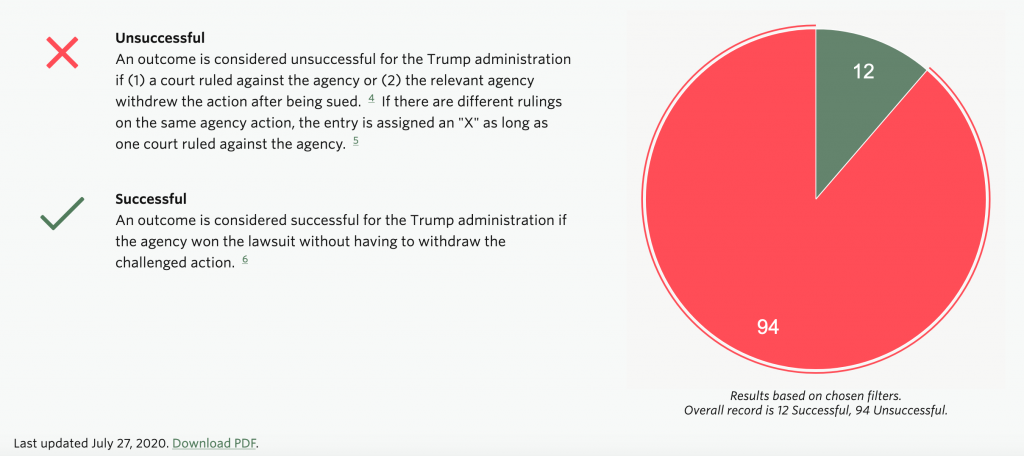
And perhaps more importantly, the lack of federal climate action has moved the spotlight to state and local governments, which often have significant sovereignty to enact aggressive policies that add up to serious national climate action. Take renewable energy, for example, per the Center for American Progress, with this map of states and municipal governments that have enacted 100% clean electricity standards:
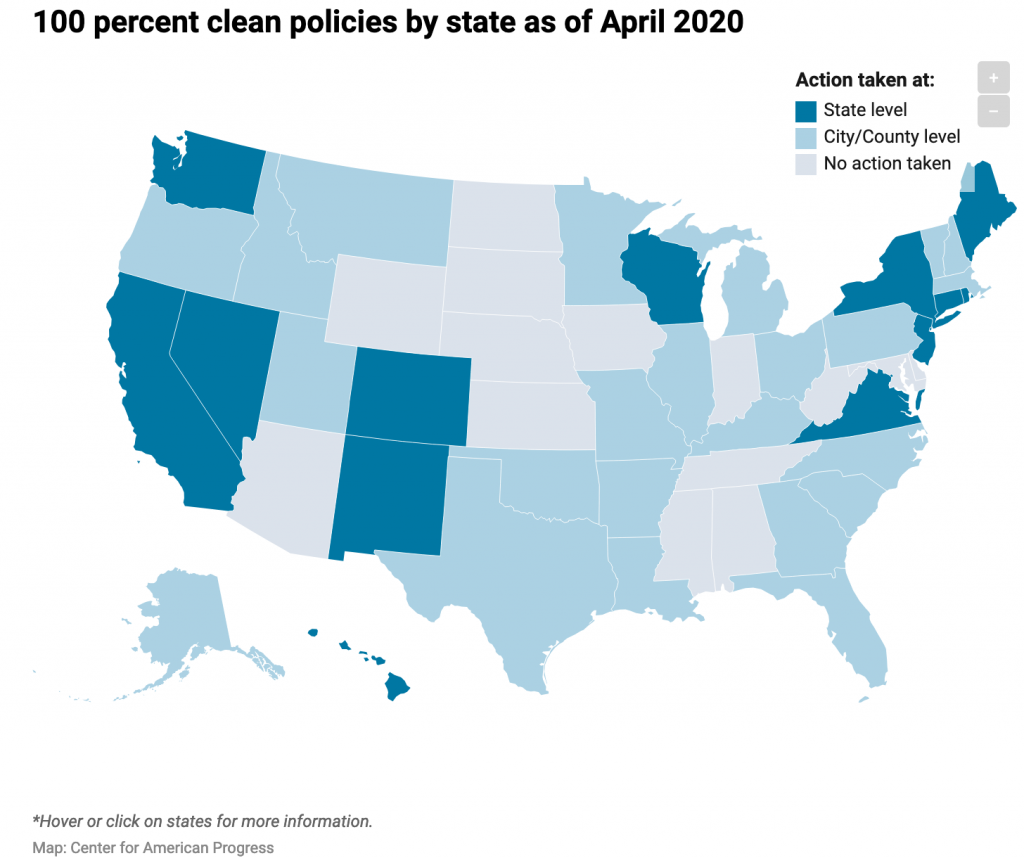
And on clean vehicle standards, 13 states plus the District of Columbia now follow California’s aggressive zero-emission vehicle standards, representing about 30 percent of the nation’s auto market.
As a result, in many ways, environmental law and climate action appears to have survived the Trump term in office mostly intact, despite losing progress and facing some setbacks on key issues. Most of the regulatory actions can be reversed by a new administration, while Congressional action during the Trump years was relatively minimal in scope. Meanwhile, the counter-reaction to Trump spurred some significant policy wins at the state and local level.
But while one term is perhaps survivable for environmental law and climate progress, a second one could paint a completely different picture. So the stakes certainly remain high this November.
California law under SB 100 (De León, 2018) requires that our electricity system run on 100% carbon-free power by 2045. That means a significant deployment of energy storage resources, like batteries, to capture surplus renewable power from the sun and wind for dispatch during dark and windless times.
While passing this law was a milestone, actually achieving this target will require siting and permitting major clean energy facilities. And perhaps no better land is appropriate for these facilities than at existing fossil fuel plants. These plants are on already-industrialized land with access to transmission lines. Converting them to energy storage facilities is a double-win: it offers a phase out of fossil fuels, while improving the air quality (and often the aesthetics) of the surrounding area.
So that’s why it’s frustrating to see one such proposed conversion to battery storage — the Moss Landing power plant battery energy storage project — potentially held up for months now by local opposition. The Monterey County Planning Commission will consider the project at its July 29th hearing.

The proposed project involves a 1,200-megawatt (MW) battery energy storage system, fit into the existing industrial footprint of the Moss Landing power plant in four two-story buildings, along with associated infrastructure (substations and inverters/converters). It will also replace existing lattice transmission towers with monopoles (staff report available here).
Most importantly, the goal of the project is to store renewable energy from the sun and wind to help California decarbonize its electricity grid. For this reason, Pacific Gas & Electric (PG&E, the local utility) selected the project and brought it to the California Public Utilities Commission for approval, with a condition that the project reach commercial operation by July 18, 2021 (PG&E advice letter here).
But a good proposal to support needed climate policy is not always enough in California. Permitting any industrial project comes with challenges and opposition, most notably compliance with environmental review under the California Environmental Quality Act (CEQA).
In this case, a review of the project under CEQA by the county revealed no significant impacts on the myriad study areas, including air quality, biological resources, water, traffic, cultural resources, and others; provided the developer implement appropriate mitigation measures. However, the developer ended up going beyond the county’s recommendations by committing to a dialogue process to identify additional mitigation measures to protect migratory birds. In short, the developer agreed to go above and beyond what CEQA requires.
Furthermore, in collaborating with the National Audubon Society and Monterey Audubon, the developer agreed not to include new transmission poles and high-voltage wires until after 2020, at which point they will conduct final design in consultation with those nonprofits. The company further committed to addressing bird safety issues in that process, including consideration of undergrounding high-voltage transmission wires.
Ultimately, the clean energy nature of the project, the county’s preparation of an environmental review document that follows CEQA, and this additional commitment to address bird safety issues were enough to gain the support of Audubon and the Sierra Club. The project appeared to face relatively easy sailing to a permit, but the planning commission delayed considering it at its July 8th meeting so that the environmental review document could be revised to clarify transmission wire placement associated with the project. Hopefully, the commission approves the project on July 29th, and no one appeals it to the Monterey County Board of Supervisors.
If California can’t allow relatively straightforward permitting of energy storage facilities at existing power plants with minimal anticipated impacts, where can they go? Not only will clean tech companies shy away from investing in California, potentially driving up costs from lack of competition, but these eyesore power plants may take longer to decommission. In the case of Moss Landing, the power plant has 500-foot dual smokestacks visible through Monterey Bay, a source of visual blight and air pollution in an otherwise unique marine and coastal environment. This battery storage project could help facilitate this decommissioning sooner rather than later, while embodying precisely the critical energy storage deployment California needs to achieve a decarbonized future.
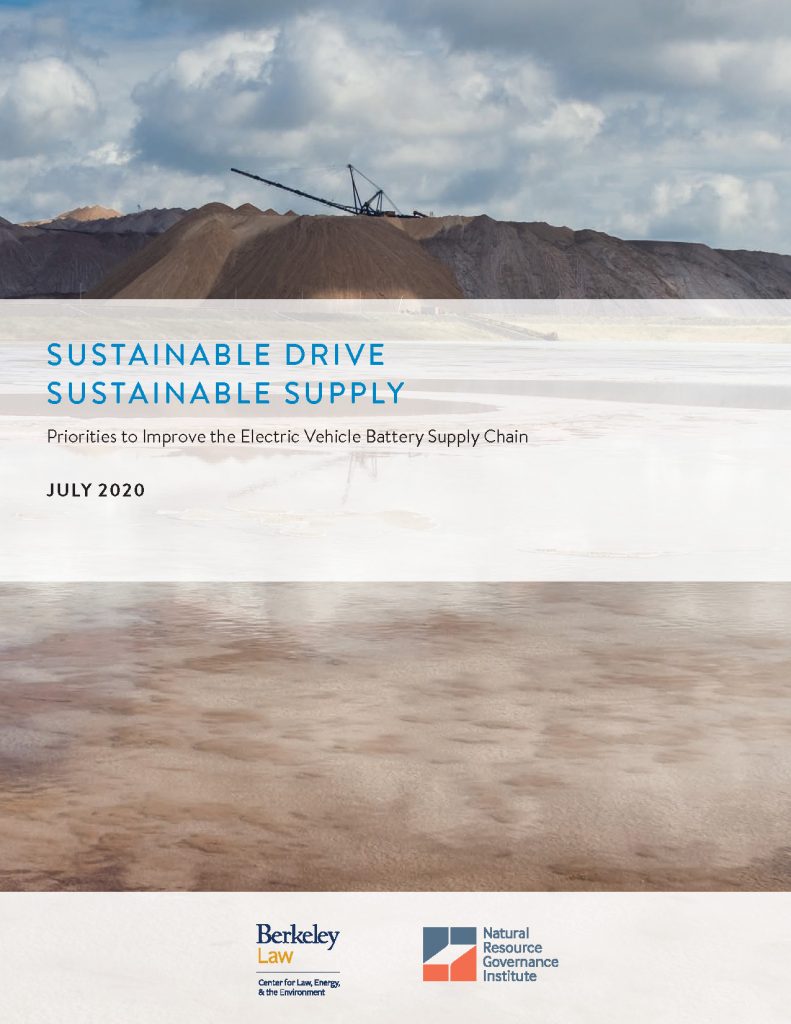
CLEE and the Natural Resource Governance Institute (NRGI) are pleased to release today the new report “Sustainable Drive, Sustainable Supply: Priorities to Improve the Electric Vehicle Battery Supply Chain.” The report identifies key challenges and solutions to ensure battery supply chain sustainability through a multi-stakeholder approach, based on our outreach to experts in the field.
The global transition from fossil fuel-powered vehicles to battery electric vehicles (EVs) will require the production of hundreds of millions of batteries. This massive deployment frequently raises questions from the general public and critics alike about the sustainability of the battery supply chain, from mining impacts to vehicle carbon emissions.
To address these questions, CLEE and NRGI are conducting a stakeholder-led research initiative focused on identifying strategies to improve sustainability and governance across the EV battery supply chain. CLEE and NRGI convened leaders from across the mining, battery manufacturing, automaker, and governance observer/advocate sectors, to develop policy and industry responses to human rights, governance, environmental, and other risks facing the supply chain.
“Sustainable Drive, Sustainable Supply” identifies the following key challenges to ensuring battery supply chain sustainability:
- Lack of coordinated action, accountability, and access to information across the supply chain hinder sustainability efforts
- Inadequate coordination and data sharing across multiple supply chain standards limit adherence
- Regulatory and logistical barriers inhibit battery life extension, reuse, and recycling
The report recommends the following priority responses that industry, government and nonprofit leaders could take to address these challenges:
- Industry leaders could strengthen mechanisms to improve data transparency and promote neutral and reliable information-sharing to level the playing field between actors across the supply chain and between governments and companies
- Industry leaders and third-party observers could ensure greater application of supply chain sustainability best practices by defining and categorizing existing standards and initiatives to develop essential criteria, facilitate comparison and equivalency, and streamline adherence for each segment of the supply chain
- Governments and industry leaders could create new incentives for supply chain actors to participate in and adhere to existing standards and initiatives, which may include sustainability labeling and certification initiatives
- Industry leaders could design batteries proactively for disassembly (enabling recycling and reuse), and industry leaders and governments could collaborate to build regional infrastructure for battery recycling and transportation and create regulatory certainty for recycling
We hope the responses to the supply chain challenges outlined in this report will provide guidance on the initial actions stakeholders can take to make this broader vision of implementation a reality, ensuring a more robust future for communities around the globe as well as for all-important electric vehicle adoption to meet climate change goals.
To learn more about this issue and the new report, join our 9am PT / Noon ET webinar today, featuring:
- Patrick Heller, Senior Visiting Fellow, Center for Law, Energy & the Environment (CLEE) & Advisor, Natural Resource Governance Institute (NRGI)
- Michael Maten, Automotive Public Policy, Electrification, Portfolio Planning and Strategy, General Motors
- Daniel Mulé, Senior Policy Advisor for Tax and Extractive Industries, Oxfam
- Payal Sampat, Mining Program Director, Earthworks
You can register for the webinar; read our recent FAQ on EV batteries for more information on current supply chain impacts on human rights, climate change and the local environments; and download the new report “Sustainable Drive, Sustainable Supply: Priorities to Improve the Electric Vehicle Battery Supply Chain.”
Note: this post is co-authored with Ted Lamm.
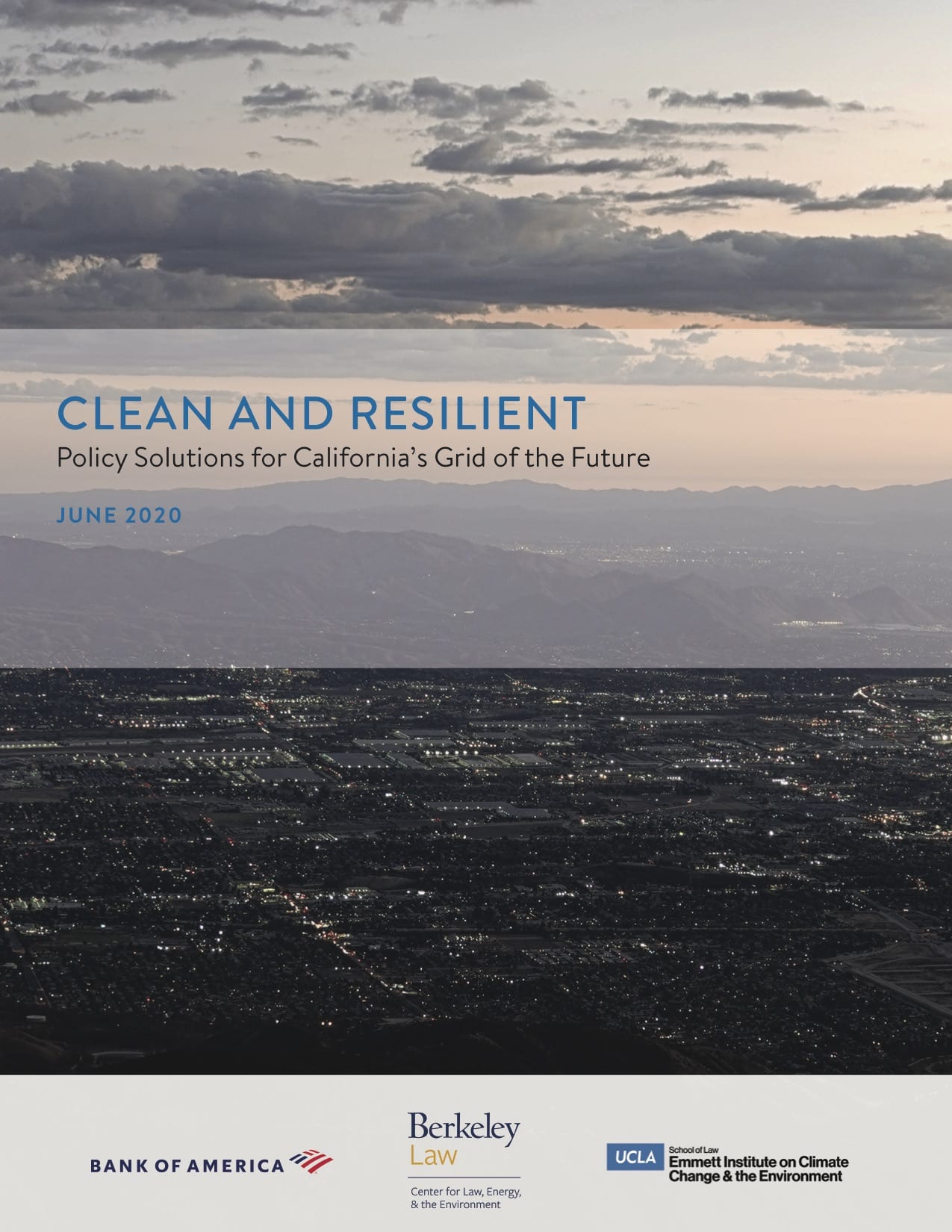
California’s electrical grid is at the center of our fight against climate change, with aggressive goals to decarbonize through renewable energy. But the grid is at risk as climate impacts become more severe, particularly from worsening wildfires. To help modernize the grid to be cleaner and more resilient, the state will need deployment of clean technologies such as distributed renewable generation, microgrids, energy storage, building energy management, and vehicle-grid integration.
Part of the vulnerability of the grid stems from its role in exacerbating climate impacts. Most prominently, power lines sparked many of the record-setting wildfires of 2017 and 2018, including the Camp Fire that destroyed the town of Paradise. To minimize this threat during high-risk weather conditions, California electric utilities and energy regulators have begun to implement preemptive power shutoffs. In 2019, widespread PSPS events likely contributed to a safer wildfire season, but the days-long shutoffs also left some vulnerable communities and residents without access to essential health and safety services.
At the same time, many residents turn to fossil-fuel backup generators during grid shutoffs, which both polluting (in terms of both greenhouse gases and locally harmful air pollutants) and unaffordable for many Californians. But the alternative—deploying clean, resilient distributed resources, such as home batteries, community solar, or microgrids—will require significant policy and financial support for grid managers, electric utilities, community choice aggregators, and local governments.
To address this need, CLEE and UCLA’s Emmett Institute convened a group of California state energy regulators, local government leaders, grid experts, and clean energy advocates for a convening on California’s electrical grid of the future. CLEE and Emmett are today releasing a new report, Clean and Resilient, based on this expert group’s findings.
The report highlights the top policy solutions the group identified to address the financial, regulatory, and data barriers to clean, resilient grid deployment, including:
- Promoting performance-based regulation at the California Public Utilities Commission, to ensure that the public benefits and necessity of investments in reliable, carbon-free technology are fully accounted for.
- Reforming grid interconnection processes (including CPUC Rules 2 and 21) to create a presumption in favor of new microgrids and other distributed technologies and to equitably share the cost of associated grid upgrades.
- Initiating a new energy data collection and management process at the California Energy Commission to ensure communities, technology providers, and regulators have access to the data that will drive the grid of the future.
You can access the report and its full set of policy recommendations here. Ultimately, developing the clean and resilient electrical grid California needs will rely on a suite of parallel initiatives, from building and vehicle electrification to advanced data and communications development, each of which will require additional support. Given the range of these interconnected efforts, and the urgency of our statewide need for a safe, reliable grid, developing coordinated policy processes to promote them is becoming increasingly essential.
Some media appearances from me this week on a range of energy, housing and rail topics:
- “Greater LA” on KCRW radio in Los Angeles covered the conspiracy theory that auto companies dismantled the vast Los Angeles streetcar network in favor of freeways, interviewing me for the segment based on my Railtown book.
- CalMatters reported on a new state legislative analysis of California’s renewable energy program, finding significant emission reductions and many research gaps, which helps deflate a Republican proposal to pause the program (with some quotes from me).
- KPCC’s AirTalk radio program featured a live discussion on Wednesday on the proposed “California Green New Deal” legislation, which in part seeks to boost affordable housing and a just transition for workers out of fossil fuels. I was joined on the program by Sylvia Chi from the Asian Pacific Environmental Network and Christopher Thornberg, founding partner of Beacon Economics.
With the legislative session just beginning, I expect the media to continue to focus on the numerous proposals to address our ongoing energy and climate needs. Happy Friday!

I began working on climate change law and policy on January 20, 2009, the day I joined Berkeley Law, which was coincidentally Barack Obama’s Inauguration Day. So it’s been a full decade for me focusing exclusively on this subject (I focused on related land use and transit issues prior to 2009), roughly coinciding with the 2010s now coming to a close.
As we mark the end of this decade, two things stand out: remarkable progress reducing the price and deploying critical clean technologies, and dispiriting failure to reduce overall greenhouse gas emissions, with more severe climate impacts happening each year.
I noted some of these trends in a foreword to “Climate Change Law in the Asia Pacific” from Berkeley Law, which features articles from scholars in places like Japan, Korea, and Taiwan, as well as California.
To summarize the good news on clean technology:
- From 2009 to 2017, the levelized costs for utility-scale solar photovoltaic dropped 86 percent;
- Wind power levelized costs dropped 67 percent from 2009-2017; and
- Lithium ion battery prices (central to electric vehicles and grid energy storage) have dropped 85 percent from 2010 to 2018.
This progress is the key reason for optimism on climate change. With the price decreases, support for deployment has increased across the political spectrum and allowed for some remarkable success stories on emissions reductions, such as California’s ability to achieve its 2020 carbon goals four years earlier, due primarily to renewable energy deployment.
But despite the progress, we have this sobering data:
- Carbon parts per million have increased from 385 in 2009 to 411 (and counting).
And unsurprisingly, the bill is now coming due. This decade has brought some of the predicted severe climate impacts, such as unprecedented wildfires, droughts, extreme rain events and hurricanes, and warming oceans.
On the positive side, the extreme weather has helped shift public opinion in favor of climate action. But it’s come at a significant cost to human life, happiness, and ecosystems.
Hopefully in the 2020s we’ll see the widespread deployment of clean technologies and other climate-smart practices that we need to stabilize and reduce emissions. And while climate impacts will inevitably worsen, perhaps our ability to withstand them will improve, such as through electricity grid resilience in the face of wildfires and using natural infrastructure to lessen storm surges and flooding.
And to make any of these positives happen, we will need smart policies and public support and political leaders to enact them. I’ve had the good fortune to work on climate policy now for over a decade, and as the 2020s dawn, much work remains.
The dark winter months are a reminder that critical renewable resources like solar PV won’t be available to keep our electricity clean. And if the wind isn’t blowing, wind power is unavailable as well to meet demand. Absent baseload renewables like geothermal power, how do we achieve a 100% carbon-free in the dark, still winter time?
The answer is bulk — or seasonal — energy storage. This means massive energy storage facilities that can capture surplus renewable power like solar PV in the summer months, and store it for months until the winter.
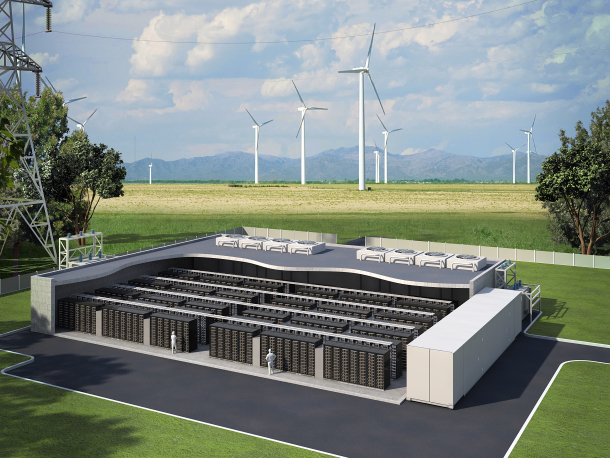
Not many technologies can achieve this mass, seasonal storage, but Utility Dive offers a helpful list, summarized here:
- Pumped Hydro: this relatively common technology involves pumping water uphill with cheap surplus electricity and then releasing it downhill to generate power when needed. It’s been in use since the 1890s, and by the end of 2017, the US had about 22 gigawatts installed.
- Compressed Air Energy Storage: this technology involves pumping air into a confined space, like a container or underground cavern, then releasing the pressure to generate electricity when needed. It’s a capital-intensive system constrained by geography. To date, I only know of two facilities in operation, although more are in the planning stages.
- Lithium-ion battery banks: with falling battery prices, these have been a “go-to” recently for energy storage. But it’s unclear if we can produce and deploy enough batteries to store power for months at grid-scale, particularly since many of these batteries will be needed for electric vehicles.
- Other batteries: By the end of 2017, the U.S. had 708 megawatts of large-scale battery capacity other than lithium, according to the U.S. Energy Information Administration.
- Gravity-based systems: more developers are experimenting with gravity-based systems, such as trains that power uphill and then go back downhill to release energy when needed, as I blogged about a few years ago. As another example, Switzerland-based Energy Vault unveiled a crane mounted on a steel tower 300 feet high, which hoists 35 metric ton concrete “bricks” into stacks. To discharge, the crane lowers the bricks to the ground.
- Hydrogen: liquid hydrogen gas can be a form of energy storage, if it’s produced with surplus renewable power. It can be stored without degrading and used to power a fuel cell or gas turbine (or to power fuel cell vehicles like hydrogen trucks).
Other technologies may exist or be in the planning stages to overcome this seasonal challenge with providing 100% carbon-free power all year. As more jurisdictions seek to meet this clean power goal, these bulk storage technologies will become critical in the near future.


